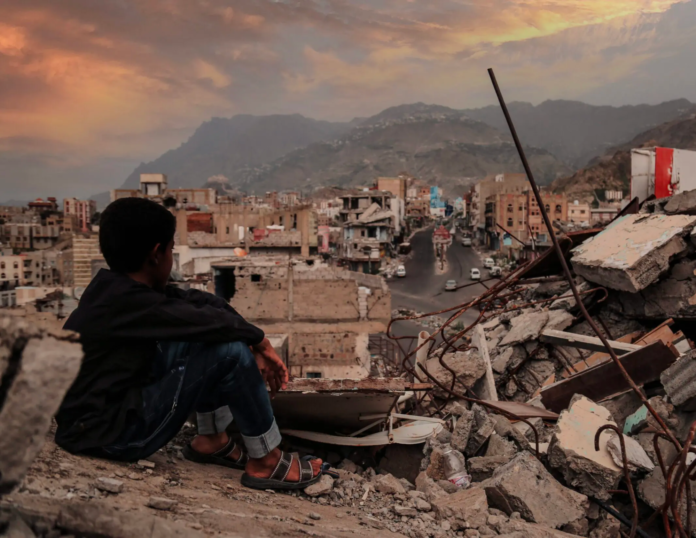Yemen is extremely vulnerable to climate change impacts being highly arid, with frequent exposure to extreme temperatures, droughts, floods, landslides and sea-level rise. The intensity of these hazards is likely to increase with the escalating crisis of global warming. The continuing Saudi-led war in Yemen compounds the impacts of climate change on its people.
The war in Yemen has been identified as one of the worst man-made humanitarian crises in human history, killing at least 233,000 people, leaving 24 million people in need of emergency humanitarian assistance and protection and 13 million people in danger of starvation.
Environmental Damage From Saudi-Led War in Yemen
Yemen’s soil, water, air and plants have been destroyed by hundreds of thousands of tons of toxic chemicals released by explosives, landmines and air raids from the ongoing war. The impacts of the toxic debris in the environment across Yemen will be felt for generations to come.
As of 2022, more than 800,000 landmines have been collected from farmlands, wells, streams, schools and almost everywhere across Yemen. Yemeni officials are unable to provide a true assessment of the scale of this catastrophe with the ongoing and escalating war.
Many water sources and farmlands across Yemen have been contaminated with toxic chemicals from landmines.
This has led to severe water and food shortages, causing malnutrition in millions of people, especially children.
Depletion of Water Reserves Leading to Absolute Water Scarcity
Experts have warned about Yemen’s water crisis since 2010, stating that its water reserves are projected to be depleted in two to three decades. The country could soon run out of water.
A country experiences water scarcity when its water reserves fall below 1,000 cubic meters (m3) per person, often termed the water poverty line, and absolute scarcity if the reserves fall below 500 m3. Alarmingly, Yemen’s freshwater reserves are merely 67 m3 per person (Figure 1).
Figure 1: Yemen’s Absolute Water Scarcity

Air Raids & Cholera Outbreaks in Yemen
The war has destroyed critical sanitation infrastructure, leading to disease outbreaks. One study found air raids from the ongoing war in Yemen have significantly contributed to the incidence of cholera outbreaks across the country.
Displacement of Vulnerable Communities
Amidst the ongoing war, Yemen’s challenges are compounded by the worsening effects of climate change, driving its people to seek sustenance, clean water, and shelter elsewhere. This war-climate nexus has forced vulnerable communities into migration, striving to escape the simultaneous burdens of war, climate change and environmental devastation.
Yemen’s dual crisis of war and climate change are disproportionately impacting the most vulnerable populations, particularly women and children, and uprooting entire communities from their homes across the country.
References
- The World Bank Group (2021). Climate Change Knowledge Portal: Yemen.
- The World Bank (2019). Renewable internal freshwater per capita (cubic meters). Website.
- Anadolu Agency. (2021). Experts assess environmental harm of armed conflict in Yemen. Article
- Inkstick (2022). Yemen’s war could cause it to run out of water. Article
- Conflict and Environment Observatory. (2021).Protected area conservation in Yemen’s conflict. Report.
- Tarnas, Maia C. and Al-Dheeb, Najwa and Zaman, Muhammad H. and Parker, Daniel M. (2023). Impact of Air Raids on the Reported Incidence of Cholera in Yemen, 2016-2019. Article.
- United Nations Department of Economic and Social Affairs. (2006). Water scarcity. Report.
- Center for Civilians in Conflict. (2022). Risking the Future: Climate Change, Environmental Destruction, and Conflict in Yemen. Report.



